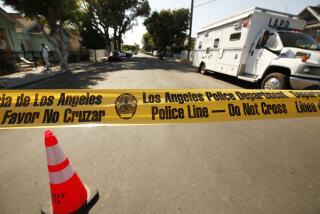Local officials ask for help in terrorism fight
- Share via
WASHINGTON — Local law enforcement agencies are working to prevent individuals in their communities from acting on extremist views but are calling for additional federal resources to help combat the threat of terrorism, a Senate panel was told Tuesday.
Recent attacks and thwarted plots against European and U.S. cities indicate a rise in homegrown terrorism, where individuals identify with violent extremism and plot to attack their home countries from within, members of several large-city police departments told the Senate Homeland Security and Government Affairs Committee.
“No agency knows their landscape better than the local law enforcement,” said Deputy Chief Michael P. Downing, commanding officer of the Counter Terrorism and Criminal Intelligence Bureau of the Los Angeles Police Department. “And we were built and designed to be the eyes and ears of communities or the first preventers of terrorism.”
Downing said local agencies were encouraging tips to police about suspicious activities and training officers to track financial transactions and recognize potential extremists’ behavior.
“It is crucial that these and other local efforts be linked together so clues to potential terrorist attacks are not lost through jurisdictional silos but are shared by local departments nationwide . . . that can connect the dots with information gathered at all levels and geographies of law enforcement,” said Sen. Joe Lieberman (I-Conn.), chairman of the committee.
The FBI sponsors more than 100 joint terrorism task forces comprising federal, state and local law enforcement officials, Special Agent Richard Kolko said. “On these task forces, all officers are treated equally, and all information is shared immediately,” he said. “We consider it a great success.”
But some local officials said more could be done to improve coordination.
Local agencies are sometimes excluded in intelligence-sharing out of concern over federal clearances, according to a prepared statement by Maj. Michael R. Ronczkowski of the Homeland Security Bureau of the Miami-Dade Police Department.
Local law enforcement officials, he said, are far more likely than federal investigators to encounter extremists during routine duties and should be outfitted to handle such situations.
“Just like providing the road officer with the physical equipment necessary and training to perform his duties, they are in need of real-time information that identifies actions or activities of extremists to look for while patrolling,” he said.
Mitchell D. Silber, a senior intelligence analyst with the New York Police Department, said the individuals most vulnerable to radicalization tended to be relatively “unremarkable”: Typically, they are male Muslims ages 15 to 35 from varied ethnic backgrounds. Significant portions come from middle-class backgrounds, and many are educated to at least high school level.
Although there is no evidence of a direct link to overseas terrorist organizations, Silber said, radicalized individuals use groups like Al Qaeda as their ideological inspiration, interacting with like-minded extremists on the Internet, which serves as a “virtual echo chamber” in reinforcing their newfound beliefs.
Downing said the LAPD had launched a “community mapping” initiative to plot the locations of Muslim populations around Los Angeles and examine their histories, demographics and socioeconomic standing. The department hopes to identify communities susceptible to extremism and prevent violent ideologies from taking root, he said.
The Department of Homeland Security remains committed to working with state and local agencies on grant and training programs, spokeswoman Laura Keehner said.
“We are open to finding ways to better serve our processes and serve their needs,” she said.
--
theo.milonopoulos@ latimes.com
More to Read
Sign up for Essential California
The most important California stories and recommendations in your inbox every morning.
You may occasionally receive promotional content from the Los Angeles Times.










